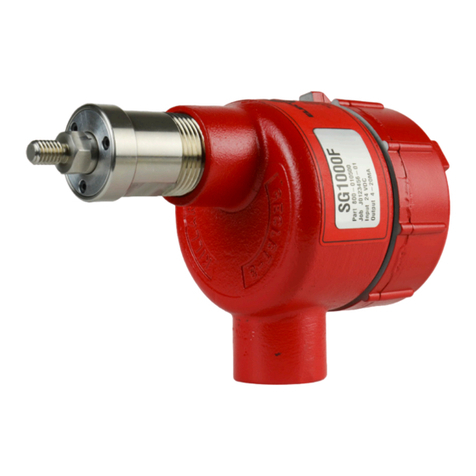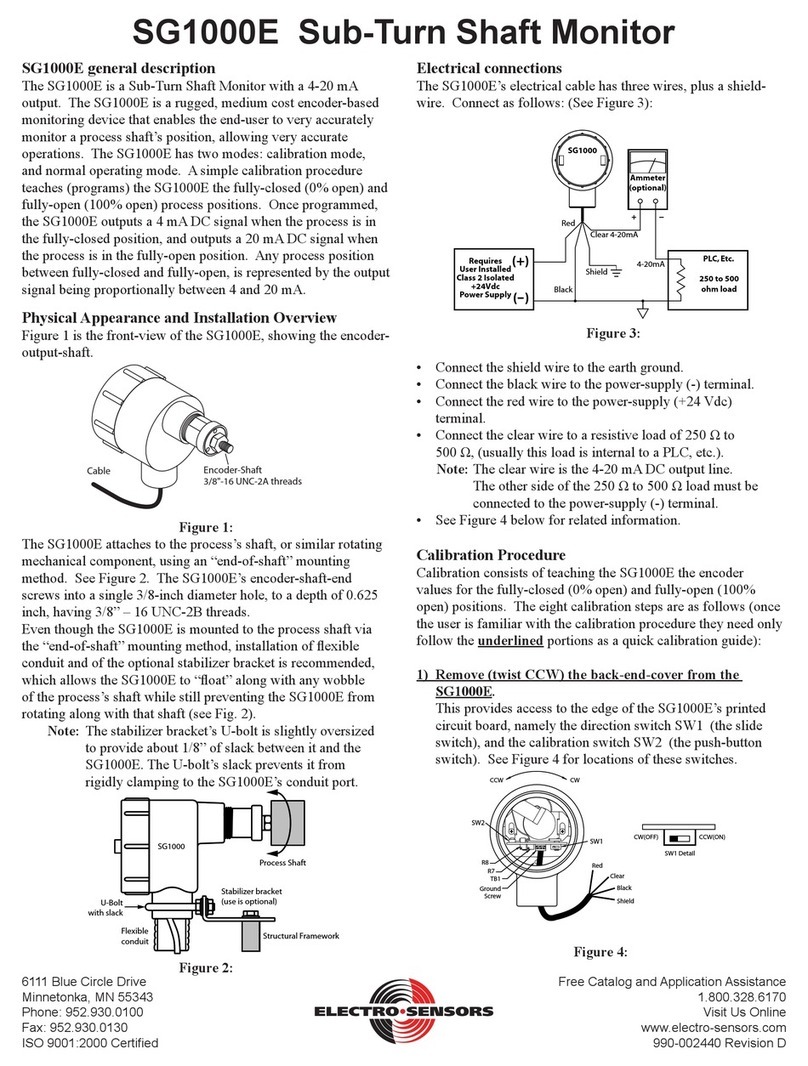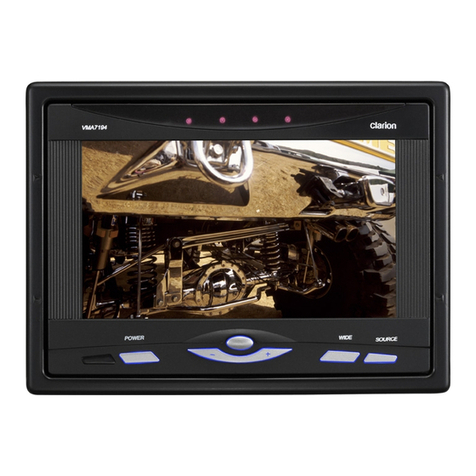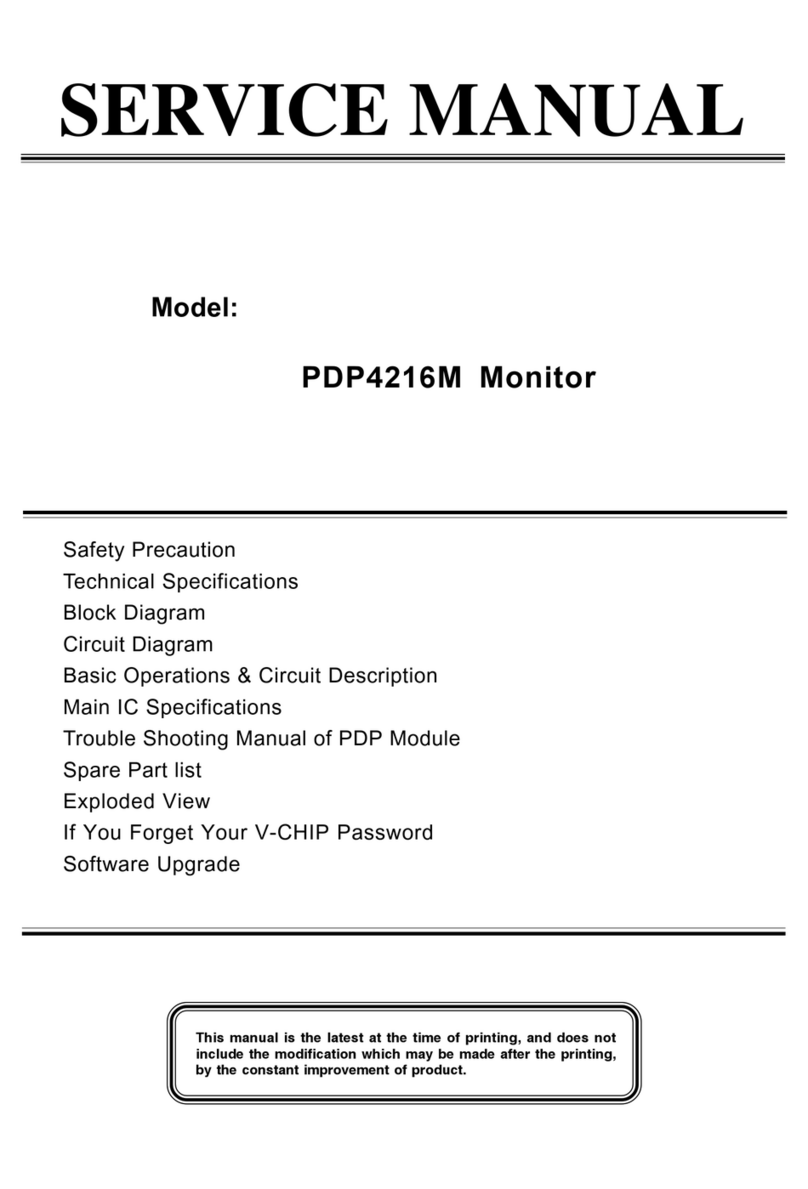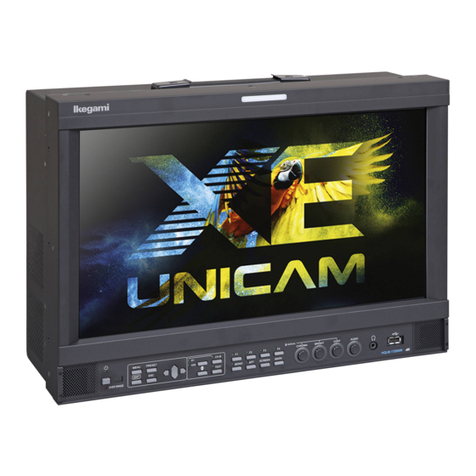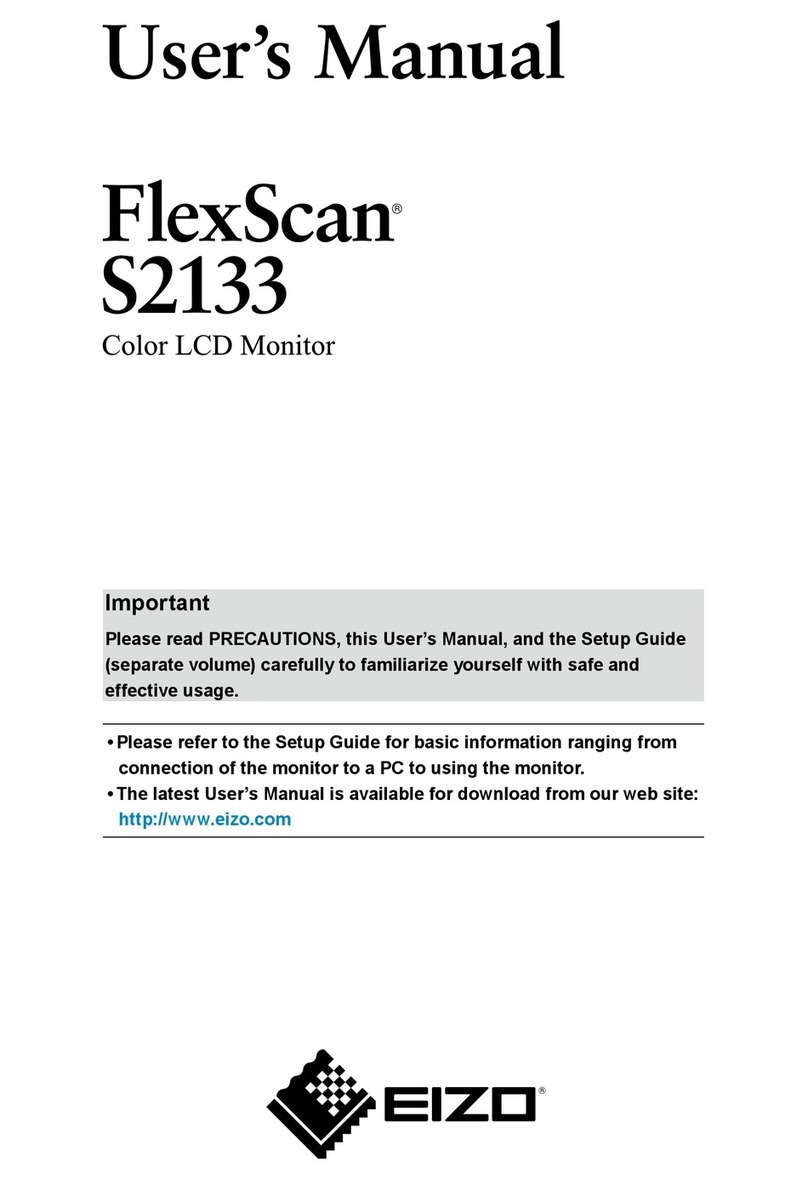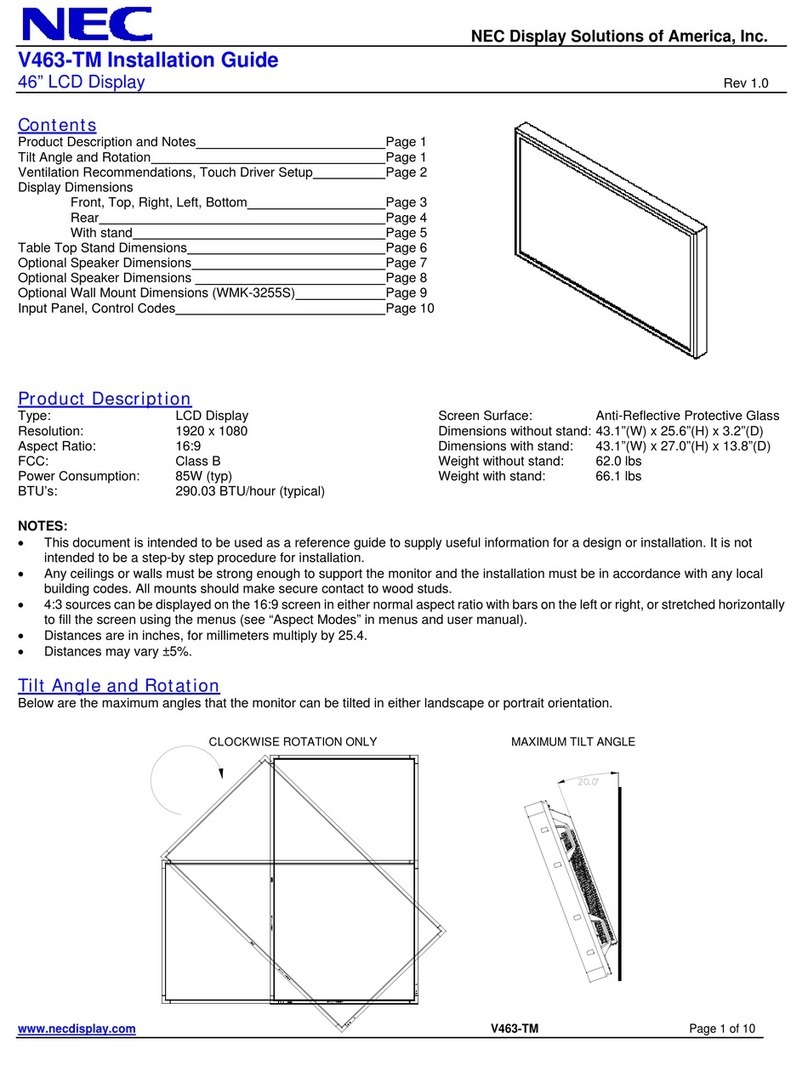Electro-Sensors SG1000D User manual

SG1000D general description
The SG1000D is a Damper-valve Monitor with a 4-20 mA
output. The SG1000D is a rugged, medium cost encoder-based
monitoring device that enables the end-user to very accurately
monitor a damper-valve’s position, allowing very accurate
operations. The SG1000D has two modes: calibration mode,
and normal operating mode. A simple calibration procedure
teaches (programs) the SG1000D the fully-closed (0% open) and
fully-open (100% open) valve positions. Once programmed,
the SG1000D outputs a 4 mA DC signal when the valve is in the
fully-closed position, and outputs a 20 mA DC signal when the
valve is in the fully-open position. Any valve position between
fully-closed and fully-open, is represented by the output signal
being proportionally between 4 and 20 mA.
Physical Appearance and Installation Overview
Figure 1 is the front-view of the SG1000D, showing the encoder-
output-shaft.
Encoder-Shaft
3/8"-16 UNC-2A threads
3/8" Split Lockwasher
(Washer Shipped with
Stabilizer Bracket Kit)
Cable
Figure 1:
The SG1000D attaches to the damper-valve’s shaft, or similar
rotating mechanical component, using an “end-of-shaft”
mounting method. See Figure 2. The SG1000D’s encoder-
shaft-end screws into a single 3/8-inch diameter hole, to a depth
of 0.625 inch, having 3/8” – 16 UNC-2B threads. (Install 3/8”
split lockwasher, apply thread locker compound, and tighten to
8 ft-lb).
Even though the SG1000D is mounted to the process shaft via
the “end-of-shaft” mounting method, installation of exible
conduit and the stabilizer bracket is recommended, which
allows the SG1000D to “oat” along with any wobble of the
process’s shaft while still preventing the SG1000D from rotating
along with that shaft (see Fig. 2).
Note: The stabilizer bracket’s U-bolt is slightly oversized
to provide about 1/8” of slack between it and the
SG1000D. The U-bolt’s slack prevents it from
rigidly clamping to the SG1000D’s conduit port.
Process Shaft
SG1000
Stabilizer bracket
U-Bolt
with slack
Structural Framework
Flexible
conduit
Figure 2:
Electrical connections
The SG1000D’s electrical cable has three wires, plus a shield-
wire. Connect as follows: (See Figure 3):
Requires
User Installed
Class 2 Isolated
+24Vdc
Power Supply (-)
(+) PLC, Etc.
SG1000
-
+
Clear 4-20mA
4-20mA
Shield
Red
Black
250 to 500
ohm load
Ammeter
(optional)
Figure 3:
• Connect the shield wire to the earth ground.
• Connect the black wire to the power-supply (-) terminal.
• Connect the red wire to the power-supply (+24 Vdc)
terminal.
• Connect the clear wire to a resistive load of 250 Ω to
500 Ω, (usually this load is internal to a PLC, etc.).
Note: The clear wire is the 4-20 mA DC output line.
The other side of the 250 Ω to 500 Ω load must be
connected to the power-supply (-) terminal.
• See Figure 4 below for related information.
Calibration Procedure
Calibration consists of teaching the SG1000D the encoder
values for the fully-closed (0% open) and fully-open (100%
open) positions. The eight calibration steps are as follows (once
the user is familiar with the calibration procedure they need only
follow the underlined portions as a quick calibration guide):
1) Remove (twist CCW) the back-end-cover from the
SG1000D.
This provides access to the edge of the SG1000D’s printed
circuit board, namely the direction switch SW1 (the slide
switch), and the calibration switch SW2 (the push-button
switch). See Figure 4 for locations of these switches.
Shield
Black
Clear
Red
CCW CW
R8
SW1 Detail
CW(OFF) CCW(ON)
SW2
SW1
R7
TB1
Ground
Screw
Figure 4:
SG1000D Damper-Valve Position Monitor
6111 Blue Circle Drive
Minnetonka, MN 55343
Phone: 952.930.0100
Fax: 952.930.0130
ISO 9001:2000 Certied
Free Catalog and Application Assistance
1.800.328.6170
Visit Us Online
www.electro-sensors.com
990-002430 Revision F

Note: Also on the edge of the PC board are two adjustment
potentiometers, R7 and R8, and a 3-pin terminal TB1.
Pot R7 is for tweaking the 4 mA output level. Pot R8 is
for tweaking the 20 mA output level. These two pots are
factory-adjusted, and the user normally should not have to
adjust them. It is best to leave these two pots alone.
The user normally should not have to disconnect the
3-wire cable from the SG1000D. But if they do so, they
must reconnect the 3-wire cable to the SG1000D as
follows:
• Power supply (+24Vdc) terminal red wire to TB1-1.
• 4-20mA signal clear wire to TB1-2.
• Power supply (-) terminal black wire to TB1-3.
2) Before entering Calibration Mode, set the direction
switch SW1 on the SG1000D’s PC board to the proper
position for the application.
SW1 tells the SG1000D the direction the encoder turns,
CW or CCW, as the valve is moved from the fully-closed
to the fully-open position. The CW or CCW direction is
dened via the viewer looking at the back-cover-end of the
enclosure, and not the encoder-shaft-end of the enclosure:
• If the encoder shaft turns in the CW direction as the valve
is moved from the fully-closed to the fully-open position,
then set SW1 to the OFF position (i.e., toward the center
of the PC board). See Figure 4.
• If the encoder shaft turns in the CCW direction as the
valve is moved from the fully-closed to the fully-open
position, then set SW1 to the ON position (i.e., toward
the edge of the PC board). See Figure 4.
Note: The direction switch SW1 is monitored only briey as
the SG1000 enters into Calibration Mode. But once
inside Calibration Mode, SW1 is no longer relevant.
Hence, changing SW1 at this point has no eect.
Because of this, SW1 must be set to the desired
position before Calibration Mode is entered in order
to capture the desired setting of SW1.
3) There are two ways to enter Calibration Mode:
• One, remove the +24Vdc power, press-in and hold the
calibration switch SW2, then reapply the +24Vdc power.
(This is referred to as “power-up” entry into calibration
mode).
• Or two, while the SG1000 remains powered, press-in
and hold the calibration switch SW2, for a constant 5 to
6 seconds. (This is referred to as “on-the-y” entry into
calibration mode).
(Do not press SW2 multiple times or allow it to change state,
just keep it pressed-in). Continue to keep SW2 pressed-in
for a few seconds until the SG1000 outputs a constant 12 mA
from its signal line, then release the button.
The SG1000D is now in the calibration mode.
4) Move the valve to the fully-closed position (i.e., 0%
open).
5) Momentarily press the calibration switch SW2.
• This captures the present encoder count. This value is
then used for the fully-closed position (0% open).
• The output signal remains at 12 mA.
6) Move the valve to the fully-open position (i.e., 100%
open).
Note: As the valve moves from fully-closed to fully-open,
the SG1000D’s encoder shaft must turn at least 15º,
but not more than a 359º turn. Hence, if the shaft
turns more than 359º, or less than 15º, then the
SG1000D will not work properly for the application.
7) Momentarily press the calibration switch SW2.
• This captures the present encoder count. This value is
then used for the fully-open position (100% open).
• The SG1000D then automatically exits the calibration
mode and enters the normal operating mode.
Note: The calibration mode is exited at this point for both
valid and invalid calibrations.
For a valid calibration: If the user does not
immediately move the valve, then the output signal
is 20 mA. (Because the valve was left in the fully-
open position from step 6, the output signal is at
100%, which is 20 mA).
For an invalid calibration: The output signal
remains at 12 mA.
See the “Valid Calibration” and “Invalid Calibration”
sections below for details regarding whether, or not, your
SG1000D accepted the valve’s two calibration positions.
8) Replace the back-end-cover onto the SG1000D.
This ends the calibration procedure.
Valid Calibration (Normal Operating Behavior)
Assuming the user followed the calibration process correctly,
the SG1000D behaves as follows:
• When the valve is at the fully-closed position (0% open), the
output signal is 4 mA.
• When the valve is at the fully-open position (100% open), the
output signal is 20 mA.
• Any valve position between 0% open and 100% open is
represented by the output signal being proportionally between
4 mA and 20 mA.
• If the valve is moved to a position that is slightly beyond
(outside of) the fully-closed (0% open) calibrated position,
then the output signal remains at 4 mA. This is known as
0% ‘run-out’, and it holds to a certain point. If the encoder is
turned far enough beyond the fully-closed calibrated position,
then the encoder “wraps-around” and the output signal jumps
to the fully-open value of 20 mA.
2-4
Free Catalog and Application Assistance
1.800.328.6170
Website: www.electro-sensors.com
990-002430 Revision F

Valid Calibration (cont.)
• If the valve is moved to a position that is slightly beyond
(outside of) the fully-open (100% open) calibrated position,
then the output signal remains at 20 mA. This is known
as 100% ‘run-out’, and it holds to a certain point. If the
encoder is turned far enough beyond the fully-open calibrated
position, then the encoder “wraps-around” and the output
signal jumps to the fully-closed value of 4 mA.
• For a properly calibrated SG1000D, the direction of
calibration (CW or CCW), and the encoder values for the
fully-closed and fully-open valve positions are all stored in
the SG1000D’s EEPROM memory.
Note: Since a properly calibrated SG1000D can never enter the
calibration mode again by itself after the calibration mode
is exited, the direction switch SW1 and the calibration
switch SW2 are ignored (during normal operating mode).
This means that for a properly calibrated SG1000D the
calibration results are protected until the user wants to
purposefully enter calibration mode again.
If re-calibration is needed, see the section below titled
“How to clear-out the existing calibration and
reprogram the SG1000D.”
Invalid Calibration (Error condition behavior)
Assuming the user followed the calibration process incorrectly,
the SG1000D behaves as follows:
• The output signal remains at a constant 12 mA after the
calibration mode is automatically exited.
An “invalid calibration” is most likely due to one of the
following errors:
- If the user did not move the valve (or moved it but less
than a 15º turn of the encoder shaft) between teaching the
SG1000D the fully-closed and fully-open positions, then
the closed and open positions have the same (or nearly the
same) encoder count.
- The user “double-pressed” SW2 during power-up or while
teaching the SG1000D the fully-closed position.
Power-ups; calibration vs. normal operating mode
• An SG1000D that is un-calibrated (or if the calibration
attempt was invalid) automatically powers-up in the
calibration mode, the next time power is applied.
• A properly calibrated SG1000D powers-up in the normal
operating mode, when power is applied.
• If the user accesses calibration mode via the “power-up”
method then any previous calibration is immediately cleared.
• If the user accesses calibration mode via the “on-the-y”
method, then any previous calibration is retained until the
new calibration points have been acquired. (This allows
the user the option to bail out of calibration mode before
completing the new calibration by simply removing the
+24Vdc power. In this case of intended power interruption,
the EEPROM never gets called to save any new calibration,
thus the old calibration is retained).
Troubleshooting Hints
As an aid to troubleshooting, see gure 3 on how to connect an
ammeter to directly measure the 4-20mA output signal.
1) If your SG1000D outputs a 4 mA to 20 mA signal, but
not at the valve positions expected, then double-check the
following:
A) Before you performed the calibration procedure, did you
set the direction switch SW1 to the proper position (CW
or CCW) before entering calibration mode?
B) As your valve moves from fully-closed to fully-open,
does the SG1000D’s encoder shaft turn more than 359º,
or less than a 15º turn? If so, then the SG1000D will not
work in your application.
C) Is your SG1000D terminal TB1 wiring correct?
• Power supply (+24Vdc) terminal red wire is TB1-1.
• 4-20mA signal clear wire is TB1-2.
• Power supply (-) terminal black wire is TB1-3.
D) Assuming conditions (A), (B), and (C) are proper, and
your SG1000D still seems to behave improperly, then try
re-calibrating again, paying close attention to the eight
calibration steps.
2) If you have gone through troubleshooting hints (1A), (1B),
(1C), and (1D), and if your SG1000D seems to otherwise
respond properly, from fully-closed to fully-open, with
the only exception being that strange values other than 4
mA and 20 mA are output for the fully-closed/fully-open
positions (e.g., 3 mA at one-end and 23 mA at the other-
end), then possibly the R7 and R8 factory potentiometer
settings have been tampered with. See Figure 4 for
location of these pots.
Evidence of R7 and R8 tampering is most easily seen
when in the calibration mode. When R7 and R8 are at
their factory-settings, the output signal is 12 mA during
calibration mode. (Recall that the output signal remains
at 12 mA until the calibration process is completed). If
during calibration mode the output signal is not 12 mA,
then most likely the R7 and R8 factory-settings have been
tampered with.
If you feel condent that you have followed the calibration
procedure properly (perhaps have done it several times
over), and followed the troubleshooting hints in (1A),
(1B),(1C), and (1D), AND you still see strange values
other than 4 mA at one end and 20 mA at the other, then
you can attempt to restore R7 and R8 to the factory-settings
by doing the following: (This assumes you have already
calibrated your SG1000D for the fully-closed and fully-
open valve positions).
A) During normal operating mode, move the valve to your
fully-closed calibrated position. Adjust R7 until 4 mA
is output from the signal line.
B) During normal operating mode, move the valve to the
fully-open calibrated position. Adjust R8 until 20 mA
is output from the signal line.
C) You can now test and verify that your R7 and R8 are
3-4
Free Catalog and Application Assistance
1.800.328.6170
Website: www.electro-sensors.com
990-002430 Revision F

indeed set back to factory settings. Do this by re-
entering the calibration procedure. If the 4 mA to 20
mA output signal is at 12 mA (or fairly close) when in
the calibration mode, then you have properly restored
R7 and R8 settings.
D) Continue and complete the calibration procedure for
the valve’s fully-closed and fully-open positions.
How to clear-out the existing calibration, and
reprogram the SG1000 (Two methods)
One, remove +24Vdc power, then press and hold-in the SW2
button while re-applying the +24Vdc power to the SG1000D.
Continue to keep the SW2 button pressed-in for a few seconds
until the SG1000D outputs 12 mA, then release the SW2 button.
The old calibration has now been cleared-out, and the SG1000D
is in calibration mode awaiting new calibration.
Or two, while powered, press and hold-in the SW2 button for 5
to 6 seconds to enter calibration mode.
See the “Calibration Procedure” section for complete details.
SG1000D General Specications:
Input Power Input Current
REQUIRES USER INSTALLED
CLASS 2 ISOLATED
+24 VDC ±10% Power Supply
40mA max (when output
signal is at 20mA)
Input Signal Parameters
Type Rotating shaft connected to internal 9 bit, 0 to
511 count, absolute position encoder
Range of Operation
Continuous rotation with no physical end stops.
Calibratible span of 1/24th to 1 turn of output
shaft.
Internal Gear Ratio 1:1
Analog Output
Signal Parameters
Type
4-20 mA DC, with programmable end-points:
(4 mA @ user’s fully closed position)
(20 mA @ user’s fully open position)
Accuracy Resolve to 1 encoder count of calibrated span
position (span from fully closed to fully open).
4-20 mA
Resolution
Varies linearly from best of 0.2% of span,
to worst of 5.0% of span
depending on calibration
0.2% resolution occurs when calibrated at the maximum span
of 511 encoder counts, which is just less than one complete turn
(359º) of the output shaft. That is, 1 count out of 511 counts is
about 0.002, or 0.2 %
5.0% resolution occurs when calibrated at the minimum span of 21
encoder counts, which is 1/24th turn (15º) of the output shaft. That
is, 1 count out of 21 counts is about 0.05, or 5 %
Since the 4-20 mA output has a 16 mA span, a 0.2% resolution
gives an incremental change of 0.032 mA, and a 5.0% resolution
gives an incremental change of 0.800 mA.
Note: The SG1000D is commonly used in damper-valve
applications where the SG1000D’s output shaft
makes a 90º turn (or swing). When the SG1000D
is calibrated for a 90º swing the encoder uses 128
positions (or counts), i.e., 512 counts / (360º/90º) =
128 counts.
• Thus the 90º swing is resolved into 128 counts.
This is about one encoder count every 0.70º.
• Likewise, the 4-20 mA output signal’s 16 mA
span is resolved into 128 increments. This is an
output resolution of 0.125 mA per increment.
Required
impedance 4-20 mA output needs a 250 to 500 Ω load
Mechanical Parameters
Mounting End of Shaft, single drilled and tapped hole.
Mounting Threads 3/8-16 UNC x 0.625 in.
Mounting Torque 8 ft-lbs, with thread locker compound.
Housing Material Cast Aluminum
Housing
Dimensions
Cylindrical, with diameter of 3-11/16”, length
of 7-5/8” (length includes housing & shaft)
Stabilizer Bracket Mounted semi-rigidly to application’s
framework using two user supplied 5/16” bolts.
Physical/Enviroment Parameters
Class I, Groups C, D
Class II, Groups E, F, G
UL File: E249019
Additional Rating NEMA 4X, Gasket Provided
Temperature Range -40ºC to +65ºC (-40ºF to +149ºF)
Humidity 0% to 90% non-condensing
Operator Interface Parameters
One Pushbutton Enter calibration mode and calibrate for fully
closed/fully open valve positions
One Slide Switch Select calibration direction CW/CCW
Memory EEPROM retains calibration during power
failure or power shut down
Operation Modes
Normal Operating Mode: (output signal per valve position).
- Output: 4 mA to 20 mA signal proportional to valve position, for a
properly calibrated SG1000.
- Output: Constant 12 mA for an uncalibrated/miscalibrated SG1000.
Calibration Mode: (select calibration direction, calibrate for fully-
closed / fully-open valve positions).
- Output: Holds at a constant 12 mA in this mode.
Additional Information
To get additional information about the SG1000D, visit our
website at: www.electro-sensors.com
Notice:
Copyright © 2019 Electro-Sensors, Inc. All rights reserved. No part
of this document can be duplicated or distributed without the express
written permission of Electro-Sensors, Inc.
While the information in this manual has been carefully reviewed for
accuracy, Electro-Sensors, Inc. assumes no liability for any errors or
omissions in the information. Electro-Sensors, Inc. reserves the right
to make changes without further notice to any part of this manual or
product described in this manual.
4-4
Free Catalog and Application Assistance
1.800.328.6170
Website: www.electro-sensors.com
990-002430 Revision F
Other Electro-Sensors Monitor manuals
